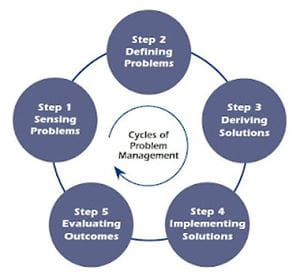Problem management and conflict modes
Ralph Kilmann

Every member in an organization can be viewed as a problem-manager, whose function can be usefully categorized into five steps:
- Sensing problems (noting whether a gap exists between “what is” and “what could or should be” that breaks a threshold of acceptability)
- Defining problems (uncovering the root cause of the gap)
- Deriving solutions (choosing ways and means to close the gap)
- Implementing solutions (putting the chosen solution to effective use in a living, breathing organization)
Evaluating outcomes (reassessing whether the gap is still beyond a threshold of acceptability and, if it is, determining which errors of problem management were made along the way)
...then the process continues.
The most damaging errors of problem management are in steps 2 and 4: defining problems and implementing solutions. Why? If you define the problem incorrectly, everything else you do in the remaining steps will be a complete waste of time and resources, no matter what the quality of the solution or how well you implement it. And if you fail to implement the solution properly - by ignoring egos, culture, resistance, fear, and office politics - you nullify everything that came before, including defining problems and deriving solutions.
The collaborating mode, therefore, is best suited for defining problems and implementing solutions. These two steps are the most complex, since they deal with multiple perspectives and human nature. They are also the most important to get right, for the reasons noted above.
As a result, it is worth the time and effort to create all the relevant conditions needed for using the collaborating mode, including cultural norms that encourage trust and candour, interpersonal skills for creative speaking and listening, a genuine spirit of teamwork and cooperation, and a performance appraisal system that explicitly rewards an engaging dialogue for complex problems.
Sensing problems and evaluating outcomes, however, are largely go/no-go decisions. Do we proceed (or continue) with problem management, or do we stop the process? As such, the conflict modes along the distributive dimension - competing, accommodating, and compromising - work just fine in the first and last steps of problem management. Either you proceed or not (one person accommodates the other or insists on proceeding with the process) or you both develop a compromise approach (proceeding for a certain amount of time, until you can better assess the importance of the gap).
The step of deriving solutions is also relatively simple - even if it can involve a lot of details - once the problem has already been defined. Usually, several alternative solutions are possible with a decision-making model, such as doing an expected-value or cost-benefit analysis. A combination of competing and accommodating can then be used to select one of the proposed solutions, depending on how important the solution is to one person versus the other, or compromising can be the mode of choice - deriving a solution that combines a few features of the different proposed solutions.
In the final analysis, the particular conflict modes used during each step of problem management have a great bearing on organisational success. If people avoid the large gaps between strategic goals and current performance, or between what key stakeholders want and what they receive, everyone will suffer. And if the two most important steps of problem management - defining problems and implementing solutions - are avoided, minimized, or addressed on the distributive dimension, the members will cycle through the steps of problem management, again and again, with all their gaps remaining the same or actually getting worse. Instead, using the right conflict mode for the appropriate step of problem management will increase the likelihood of resolving the organization’s most important problems, the first time around.
For a thorough discussion of problem management, check out
www.kilmanndiagnostics.com/problem.html.
Ralph H. Kilmann, PhD, is CEO and Senior Consultant at Kilmann Diagnostics in Newport Coast, California. Formerly, he was the George H. Love Professor of Organization and Management at the Katz School of Business, University of Pittsburgh – which was his professional home for 30 years. He earned both his BS degree and MS degree in industrial administration from Carnegie Mellon University (1970) and a PhD degree in management from the University of California, Los Angeles (1972). Kilmann is co-author of the TKI assessment and has published more than twenty books and one hundred articles on conflict management, problem management, organizational design, change management, and quantum organizations.